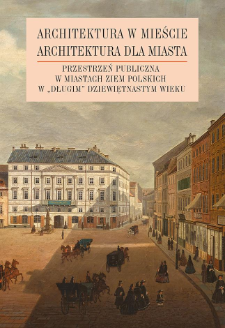- Search in all Repository
- Literature and maps
- Archeology
- Mills database
- Natural sciences
Advanced search
Advanced search
Advanced search
Advanced search
Advanced search

Object
Title: Modyfikacje przestrzeni miejskiej na przykładzie placu Teatralnego w Toruniu : dziedzictwo materialne i treści znaczeniowe
Subtitle:
Architektura w mieście, architektura dla miasta : przestrzeń publiczna w miastach ziem polskich w "długim" dziewiętnastym wieku ; Zabór pruski/niemiecki i prowincja śląska
Contributor:
Łupienko, Aleksander (1980– ) : Redaktor ; Zabłocka-Kos, Agnieszka (1957– ) : Redaktor ; Polska Akademia Nauk. Instytut Historii im. Tadeusza Manteuffla
Publisher:
Place of publishing:
Description:
509 stron : ilustracje (w tym kolorowe) ; 24 cm ; Abstrakt w języku angielskim.
Type of object:
Abstract:
Theatre Square in Toruń was formed in the second half of the nineteenth century as a result of general functional and spatial transformations that were undertaken after the demolition of the town’s medieval walls, gates and towers at the side of its suburbs. The main element of fortifications on the north was the Chełmno Gate, which had survived to 1889. In 1880, the German architect Johannes Otzen erected a monument in the promenade near the gate in honour of the fallen, which became the central element of the square until 1920. From the 1890s on, the particular frontages of the square were formed. On the east, a modern hotel was erected (Thorner Hof), and next to it, in 1901, a district administrative building was built (Kreishaus) to the design of the German architect Hugo Hartung. The square’s name was established in 1904, after the Municipal Theatre was constructed according to the design of the Vienna architects Ferdinand Fellner and Hermann Helmer. The medieval granaries, located on the southern side, were transformed into modern tenement blocks, and a corner building rebuilt by the architect Erich Lindenburger housed the saving association Vorschuss Verein. The Theatre Square in Toruń is a construct of imperial German town planning. It reflected the aspirations of local government to create a representative square as befitted modern times. It satisfied the aims of a small urban centre in the Prussian state which, despite the engagement of the town’s officials and intellectual circles, was able to create only a poor substitute of the metropolitan atmosphere of cities such as Berlin and Vienna. The representative and multifunctional character of the Theatre Square has been preserved to this day.
Start page:
End page:
Detailed Resource Type:
Resource Identifier:
oai:rcin.org.pl:140651 ; 978-83-65880-53-6
Source:
IH PAN, sygn. II.14682 ; IH PAN, sygn. II.14681 Podr. ; click here to follow the link
Language:
Language of abstract:
Rights:
Licencja Creative Commons Uznanie autorstwa-Bez utworów zależnych 4.0
Terms of use:
Zasób chroniony prawem autorskim. [CC BY-ND 4.0 Międzynarodowe] Korzystanie dozwolone zgodnie z licencją Creative Commons Uznanie autorstwa-Bez utworów zależnych 4.0, której pełne postanowienia dostępne są pod adresem: ; -
Digitizing institution:
Instytut Historii Polskiej Akademii Nauk
Original in:
Biblioteka Instytutu Historii PAN
Access:
Object collections:
- Digital Repository of Scientific Institutes > Partners' collections > Institute of History PAS > Books
- Digital Repository of Scientific Institutes > Partners' collections > Institute of History PAS > Institute Publications
- Digital Repository of Scientific Institutes > Partners' collections > Institute of History PAS > Institute Publications > Books
- Digital Repository of Scientific Institutes > Literature > Books/Chapters
Last modified:
Oct 2, 2020
In our library since:
Sep 23, 2020
Number of object content downloads / hits:
101
All available object's versions:
https://rcin.org.pl./publication/175771

 INSTYTUT ARCHEOLOGII I ETNOLOGII POLSKIEJ AKADEMII NAUK
INSTYTUT ARCHEOLOGII I ETNOLOGII POLSKIEJ AKADEMII NAUK
 INSTYTUT BADAŃ LITERACKICH POLSKIEJ AKADEMII NAUK
INSTYTUT BADAŃ LITERACKICH POLSKIEJ AKADEMII NAUK
 INSTYTUT BADAWCZY LEŚNICTWA
INSTYTUT BADAWCZY LEŚNICTWA
 INSTYTUT BIOLOGII DOŚWIADCZALNEJ IM. MARCELEGO NENCKIEGO POLSKIEJ AKADEMII NAUK
INSTYTUT BIOLOGII DOŚWIADCZALNEJ IM. MARCELEGO NENCKIEGO POLSKIEJ AKADEMII NAUK
 INSTYTUT BIOLOGII SSAKÓW POLSKIEJ AKADEMII NAUK
INSTYTUT BIOLOGII SSAKÓW POLSKIEJ AKADEMII NAUK
 INSTYTUT CHEMII FIZYCZNEJ PAN
INSTYTUT CHEMII FIZYCZNEJ PAN
 INSTYTUT CHEMII ORGANICZNEJ PAN
INSTYTUT CHEMII ORGANICZNEJ PAN
 INSTYTUT FILOZOFII I SOCJOLOGII PAN
INSTYTUT FILOZOFII I SOCJOLOGII PAN
 INSTYTUT GEOGRAFII I PRZESTRZENNEGO ZAGOSPODAROWANIA PAN
INSTYTUT GEOGRAFII I PRZESTRZENNEGO ZAGOSPODAROWANIA PAN
 INSTYTUT HISTORII im. TADEUSZA MANTEUFFLA POLSKIEJ AKADEMII NAUK
INSTYTUT HISTORII im. TADEUSZA MANTEUFFLA POLSKIEJ AKADEMII NAUK
 INSTYTUT JĘZYKA POLSKIEGO POLSKIEJ AKADEMII NAUK
INSTYTUT JĘZYKA POLSKIEGO POLSKIEJ AKADEMII NAUK
 INSTYTUT MATEMATYCZNY PAN
INSTYTUT MATEMATYCZNY PAN
 INSTYTUT MEDYCYNY DOŚWIADCZALNEJ I KLINICZNEJ IM.MIROSŁAWA MOSSAKOWSKIEGO POLSKIEJ AKADEMII NAUK
INSTYTUT MEDYCYNY DOŚWIADCZALNEJ I KLINICZNEJ IM.MIROSŁAWA MOSSAKOWSKIEGO POLSKIEJ AKADEMII NAUK
 INSTYTUT PODSTAWOWYCH PROBLEMÓW TECHNIKI PAN
INSTYTUT PODSTAWOWYCH PROBLEMÓW TECHNIKI PAN
 INSTYTUT SLAWISTYKI PAN
INSTYTUT SLAWISTYKI PAN
 SIEĆ BADAWCZA ŁUKASIEWICZ - INSTYTUT TECHNOLOGII MATERIAŁÓW ELEKTRONICZNYCH
SIEĆ BADAWCZA ŁUKASIEWICZ - INSTYTUT TECHNOLOGII MATERIAŁÓW ELEKTRONICZNYCH
 MUZEUM I INSTYTUT ZOOLOGII POLSKIEJ AKADEMII NAUK
MUZEUM I INSTYTUT ZOOLOGII POLSKIEJ AKADEMII NAUK
 INSTYTUT BADAŃ SYSTEMOWYCH PAN
INSTYTUT BADAŃ SYSTEMOWYCH PAN
 INSTYTUT BOTANIKI IM. WŁADYSŁAWA SZAFERA POLSKIEJ AKADEMII NAUK
INSTYTUT BOTANIKI IM. WŁADYSŁAWA SZAFERA POLSKIEJ AKADEMII NAUK


































